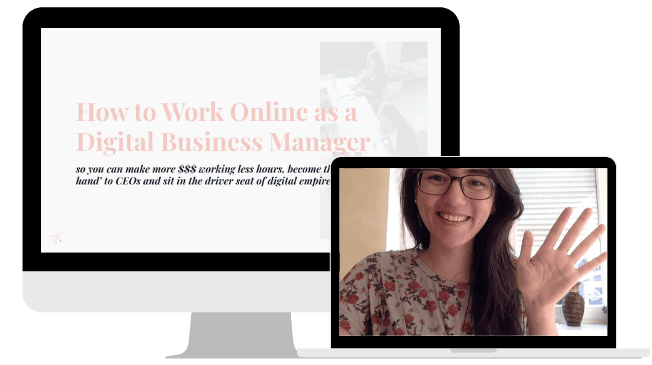Feeling nervous about freelancing because you’ve been told it’s risky, financially unstable, and stressful? Been there, friend!
I used to imagine freelancing as a wild rollercoaster of ups and downs… which it can be. But it doesn’t have to be if you put the right measures to protect yourself in place.
As a risk-averse, Type A, full-time freelancer of 5 years, I want to share a few important steps I implemented to avoid as much risk as possible in my freelancing career.
So here are 9 ways to make freelancing less risky...
🗓 #1: Set Up Monthly Retainers
There’s a strong misconception that as a freelancer you have to and can only bill hourly.
In the beginning, hourly may make sense as you are still figuring out how long tasks take but this is something I recommend moving away from ASAP.
Hourly tends to be the most recognized form of freelancing, but you can bill whichever way you want. That is your right as a freelancer.
So… What is a monthly retainer?
A monthly retainer is my personal favorite format to charge money to clients. Essentially the client pays a fixed amount of money to retain your time every month.
Every single month at the end of the month or the beginning of the month (whenever you invoice), you get a set amount of money from that client.
It does not fluctuate and It does not depend on the hours worked that month.
The client is retaining you for that fixed amount. And that’s what you’re going to be paid, regardless of what happens during the month.
A monthly retainer can vary from hundreds to thousands as a freelancer. And more importantly, this gets you off of that financial fluctuation wave.
Now, if you’re wondering “Okay, Deya. I charge hourly now. How do I move my hourly clients to retainer setups?”
Check out this video below where I talk about how to move from hourly to package rates. It’s important to detach your time from your income as soon as you can to ensure you’re not being penalized for getting better and faster at your job. ↓

🤝 #2: Have Notice Periods In Your Freelance Contracts
The second way to make things less risky is to include notice periods in your freelance contract.
You can build them into the agreement that the client signs when they begin working with you. This can be anything but tends to be 2 to 4 weeks’ notice. It should ideally be the amount of time it takes you to replace that income.
This is just like any corporate or office job where you have a notice period in your contract. Notice periods ensure you have a bit of buffer in case a client does want to let you go.
📧 #3: Never Stop Applying To Freelance Jobs
When I first started as a freelancer, I was applying to a lot of jobs because I didn’t have a lot of client work, so my time distribution was mostly applying and very little client work.
As time went on, I applied less because I was doing more client work, but I continued to apply even when I was fully booked.
Even when I was fully booked out as a freelancer, I was still applying for jobs.
Even when I was hitting my income goals, I was still applying because:
- 👉 I knew I had a backup plan if a client were to let me go.
- 👉 It was a psychological safety net knowing there were other options out there.
Another benefit of applying consistently is it keeps your interviewing skills up to date.
It’s important not to get too comfortable just because you’re booked out. You don’t want to find yourself in a situation where you have to find new clients, but haven’t been applying or interviewing actively, which means you need a bit of time to dust off the cobwebs and practice.
Applying actively also gives you options.
When we have options, everything is easier. When you have a difficult client, or you have a client that you have outgrown, you can always let them go and slot in a better client.
This leaves you feeling more confident when letting a client go because your client roster is always on the up and up.🗑 #4: Filter Freelance Clients Carefully
This tip will go a long way to sustainability in your freelance career.
We don’t want to say yes to absolutely everybody that is interested in paying us money.
Always run everybody through your own set client filter.
I have my own set of criteria as to how I judge whether a client’s going to be a good fit, beyond whether I like them or not.
One important question is: “Is this business profitable?” and to do a little research to find out if it is actually a business with a validated product, customers or clients, and cash flow. These are crucial things to ensuring you actually get paid.I would also ask:
- ❓ Do they have an existing team? Are their team members happy?
- ❓ How long have they been in business? Do they have an online presence?
You can do your own research and/or ask these questions during the discovery call or interview as well.
You want to be signing clients who are at a stage where they can provide some financial stability to you because their business is already stable.
🕸 #5: Diversify Your Client Base
Diversification is important in your client base.
If all of your clients are in the same industry and something disrupts that industry, you will quickly feel the effects of that directly as a freelancer. One example is the travel industry and how hard it was hit in 2020; if all your clients had been in the travel industry, it would have been quite difficult to pivot in the span of a few weeks.
Diversify your client base in order to lower your risk of losing a freelance role if a specific industry goes under or has a very quiet season.Try to diversify your client base a little in terms of industry, in terms of size, in terms of types of products/services offered and sold.
🥅 #6: Build A Financial Safety Net Into Your Business
The next step applies to business and life in general.
Always build a financial safety net into your business, even if it’s just setting aside $50 a month to start, or a hundred dollars a month if you can manage.
It is super helpful to have 3 to 6 months of savings for your business to ensure that you can still sustain yourself in the event of losing a client that you relied on.
This will also allow you to still carry yourself for a few months while you look for clients.
↓ And if you’re struggling with freelancer “slow season”, here’s a video on what to do during a slow season:

☝️ #7: Implement Changes One Client At A Time
Here’s a quick but important tip!
When you plan to increase your rates, don’t send out a rate raise email to all of your clients saying, “Hey, my rates are increasing as of April 1st and I hope you all get on board”.
We don’t want to make policy changes across the board to every single client we have on our roster at the same time.
I always recommend making changes client by client to ensure that the risk level is lower for you.
Making big changes one client at a time helps you to be sure that if it is not received well by that first client then you can learn from that and adjust accordingly.🕊 #8: Never Sacrifice Mental Wellness For Profit
Final and most important tip: you are your biggest asset as a freelancer so never ever sacrifice your mental wellness for any amount of profit.
You need to treasure, cherish, love and care for yourself as if you were the most valuable asset you have in your business, because you are.
Going at a comfortable pace as a freelancer for two years is better than going super hard and burning yourself out in two weeks.
I know it can be tricky when you’re first starting as a freelancer to know your boundaries, but boundaries are truly non-negotiable if you want to be a sustainable freelancer.
Another note: to make freelancing less risky and more sustainable, make sure you are dropping clients that are not good for you.
If you notice over time that a client is genuinely not respectful or bad for your mental wellbeing, it may be time to say goodbye. If you feel all your energy is depleted by 1 client so much so that you don’t have energy for your other clients, then you might want to consider letting them go so that you can make more room and energy for the clients that are treating you well.This will also give you more time to look for clients that are your ideal type of client.
⭐️ #9: Make Yourself Indispensable To Your Freelance Clients
This final tip is the one that took me a little time to figure out, and that is: to obsess over how to be indispensable to your clients. Being indispensable means that the work you do is truly so valuable a client needs you to run their business and cannot do it without your help.
So what is your unique selling proposition?
Take some time and craft your unique selling proposition.
- ✏️ What do you bring to the table?
- ✏️ What are your hard skills?
- ✏️ And more importantly, what are your soft skills?
Write down how you are different to other freelancers in your industry.
My top tips for making yourself indispensable to a client:
- 💡 Learn how to do the thing that your client strongly dislikes doing.
- 💡 Figure out what tasks in the business are most closely tied to revenue and have the highest return on investment and learn those skills.
Clients will be able to see immediately the impact that you have on their business and what’s going to happen when they no longer have you on their team.
That’s actually the reason I scaled as a freelancer into a Digital Business Manager role.
At some point, I realized that my clients didn’t just need help with execution-level tasks where I was doing tasks for them, but they really needed help with the managerial side of running their businesses.
- 👩💻 They needed people to help manage teams.
- 👩💻 They needed people to keep track of projects so that they’re not keeping track of 50 projects at one time.
- 👩💻 They needed systems set up in their business to ensure that the day-to-day operations were organized and easily understood by the whole team.
So I took on all the tasks that they didn’t want to do.
This service freed up so much of their time and helped them make more money and save energy, which is what I like to call the ‘value trifecta’.
This, in my opinion, is the lowest risk you could ever have as a freelancer — it’s when your clients say “I can’t run this business without you.”
Make yourself irreplaceable, indispensable, so valuable that the client can NOT let you go and you’ll have clients forever.
If you would like to know more about managing your clients’ projects, teams, and building systems in their businesses… Join my free masterclass below to find out exactly how I grew to 6-figures as a freelance Digital Business Manager ↓

Want ALL the details on how to work online as a digital business manager?
Check out my FREE intro class which goes over what exactly a DBM does day-to-day, how much I make as a DBM, my 5-step plan to get you started and more!


